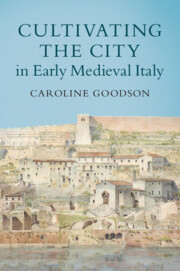Book contents
- Cultivating the City in Early Medieval Italy
- Cultivating the City in Early Medieval Italy
- Copyright page
- Dedication
- Contents
- Figures and Tables
- Acknowledgements
- Terms and Measurements
- Abbreviations
- Additional material
- 1 Urban Gardens and Gardeners
- 2 Patterns and Changes
- 3 The Shape of the Phenomenon
- 4 Alliances and Exchanges
- 5 Values and Ideals
- 6 Conspicuous Cultivation
- 7 Conclusions
- Bibliography
- Index
3 - The Shape of the Phenomenon
Published online by Cambridge University Press: 08 March 2021
- Cultivating the City in Early Medieval Italy
- Cultivating the City in Early Medieval Italy
- Copyright page
- Dedication
- Contents
- Figures and Tables
- Acknowledgements
- Terms and Measurements
- Abbreviations
- Additional material
- 1 Urban Gardens and Gardeners
- 2 Patterns and Changes
- 3 The Shape of the Phenomenon
- 4 Alliances and Exchanges
- 5 Values and Ideals
- 6 Conspicuous Cultivation
- 7 Conclusions
- Bibliography
- Index
Summary
This chapter presents the overall shape of the phenomenon, situating urban food cultivation against the backdrop of rural agriculture for urban provisioning which characterised the majority, though not the totality, of Italian agronomics. Examples from Lucca point to key issues in urban food cultivation: urban topography, relations between neighbours, and relations between landholders and larger institutions such as churches. In small, densely populated cities such as Lucca, as well as in larger cities, we can see tightly controlled cultivated spaces within the walls. Archaeobotanical evidence is providing new information about what was grown, where, and how much. Here I use it to demonstrate the radically changed cerealiculture in Italy for the fifth to seventh centuries, and then analyse in detail the floral remains of two urban gardens, one from ninth-century Rome and one from tenth- to eleventh-century Ferrara. These case studies reveal the wide range of foodstuffs cultivated in cities and the prevalence of polyculture, when growers planted many different food crops with varying harvest cycles for household consumption rather than single crops for market production.
Keywords
- Type
- Chapter
- Information
- Cultivating the City in Early Medieval Italy , pp. 76 - 114Publisher: Cambridge University PressPrint publication year: 2021

